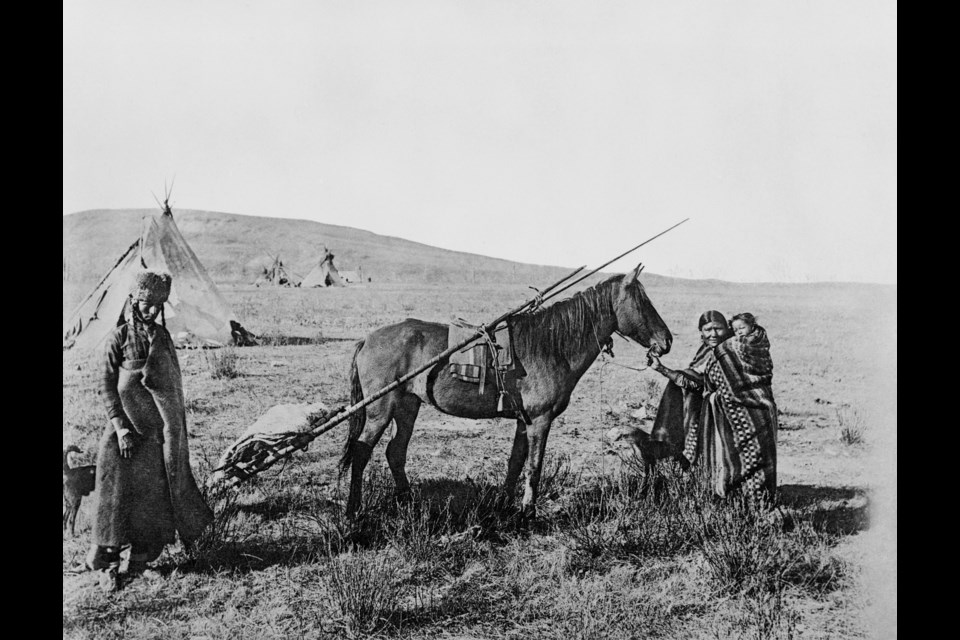ST. ALBERT - A transportation and lifestyle journey across the region’s settler era is the theme of its current exhibition which opened June 27 at Musée Heritage Museum.
Perpetual Motion; Early Travel and Transport in Central Alberta uses a mix of photographs, models, original artifacts and panels to tell a unique narrative. In it’s entirety, the exhibition conveys the surprising diversity and resourcefulness of Indigenous peoples and European settlers who travelled across the prairies on land and water.
Each photograph, artifact and model reveals how individuals, families and company employees survived and thrived under Alberta’s harsh conditions carrying tents, teepees, food and assorted supplies across kilometres of rough terrain.
From the late 19th century to just prior to the Second World War, the region’s transportation sector underwent vast changes. As part of those incredible changes from walking along the plains to driving cars on roads, came a shared knowledge about land, lifestyle and culture.
Curator Joanne White’s original concept for the exhibition was developed through the theme of freighting. She explains the Niikoo-oo-pum (Red Willow) River now the Sturgeon River was an important crossroads. Traditional trails met here veering off to join other major routes.
First Nations and Métis people followed the trails hunting for food while the fur trade set up forts in the area. Hundreds needed to be fed and clothed while packs of furs were purchased turning the area into into a major economic engine.
“The earliest locations of the Northwest Company and the Hudson’s Bay Company were near The Forks at the mouth of the Sturgeon River where it joins the North Saskatchewan. This meant Big Lake became a part of the local supply chain as an important transportation hub,” White said.
In planning the exhibition, she opted to create six sections for different methods of transportation instead of developing a linear timeline. The categories are divided into transportation on the plains, on snow, on rivers, on trails, on rails and in settlements.
The earliest mode Indigenous populations used was people power. One photo shows a man appearing to struggle while carrying a 200-pound pack on his back.
“That was fairly typical,” said White. She added that Indigenous peoples eventually built a travois which allowed them to carry more goods. A travois is two poles cinched together to carry a load pulled by a dog or horse. It carried goods and supplies to and from hunting sites and temporary settlements.
“Once Europeans arrived, the Red River Cart became a key form of transportation. The carts were modelled after the Scottish highland carts,” White said. "The wheels were made of wood and easily reparable if they broke down. But they squeaked continually because they were made of wood and had to be lubricated with axle grease. So it was anything but a quiet ride across the prairies."
Snow was and is a large part of our environment. The exhibitions showcases drawings from 1916 that document different snowshoes for different types of snow and conditions. Hanging on a wall are different types of snowshoes constructed showcasing numerous interweaving patterns and designs.
Dog sleds also became popular form of transportation where dogs were decked out in fancy harnesses, blankets, bells, feathers, ribbons.
“You took pride in your team. You took pride in your vehicle,” said White explaining the canines’ fancy attire.
Rivers were also a major form of transportation, especially to areas that were impassable by land. River transport was also at the mercy of weather.
“If a river was windy, you had to cross multiple times. Everything was so much harder.”
In fact, many supplies for Father Lacombe’s mission were ferried on the Sturgeon River via a flat-bottomed scow. White added Father Lacombe tired of wading into the river and getting his clothes wet while picking up supplies.
“He had to haul everything to the mission from the scow. He got sick and tired of crossing the river with supplies to and from Edmonton so he built the first toll bridge.”
Two decades after the Canadian National Railways was complete, the Canadian Northern Railway built a branch line to St. Albert in 1906 to haul freight. Unfortunately passenger service was not included.
Raymond Brutinel invested in St. Albert Colliers and discovered a coal vein in 1911. His vision was to build a passenger rail service that would also haul his coal to larger markets. The original plans included a network of several passenger lines.
Tracks were completed and the first gas electric car was delivered in 1913. Passenger service was begun in the fall but on April 1, 1914 the company’s only two cars were destroyed in a building fire. Brutinel considered rebuilding, but when the First World War broke out that year, he joined the war effort focusing on a motorized machine gun brigade. He retired a Brigadier-General.
“The diversity of transportation and the development of technology as well as people’s persistence is interesting and important. The amount of challenges they had to overcome to live their lives, and the tenacity of the people who came out here is a big part of our history.”
Perpetual Motion runs until September 10. The museum is located in St. Albert Place, 5 St. Anne Street.


.jpg;w=120;h=80;mode=crop)

